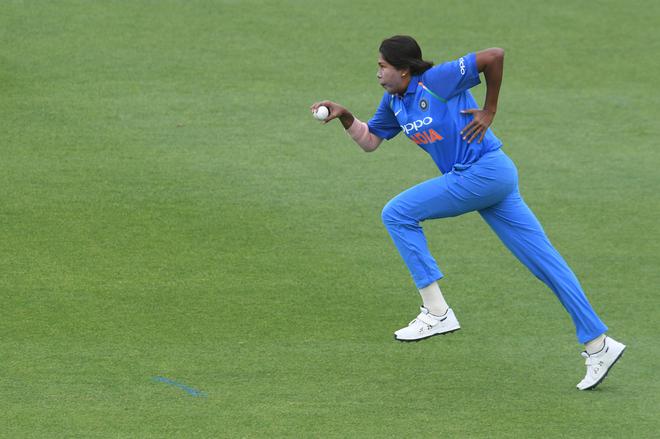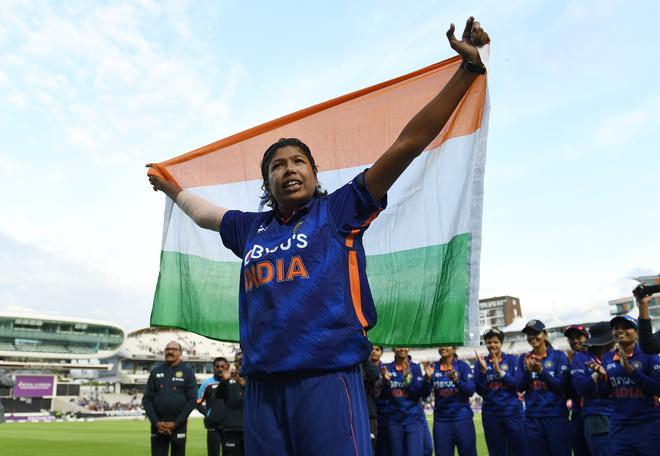

Anju Jain was first struck by the teenager’s height. She was easily the tallest of all the players assembled at Panchkula, Haryana, for the Indian team’s preparatory camp ahead of the 2000 Women’s World Cup in New Zealand.
Anju also found out that she was probably the quickest female bowler she had ever kept wicket to. There was another thing she soon noticed about the girl from a small town near Kolkata: her dedication. She felt the youngster had great potential (even if she didn’t make it to the World Cup squad).
It was around the same time that then national selector Shubhangi Kulkarni first watched her, at an under-19 tournament in Gurgaon, also in Haryana. She was impressed and thought she was good enough to play for India.
What neither Anju nor Shubhangi could have imagined at the time was that the tall girl, named Jhulan Goswami, would become the most successful bowler of all time in international women’s cricket.
Anju last met Jhulan a couple of months ago at the National Cricket Academy in Bengaluru, where she was undergoing rehabilitation, ahead of the England tour. “She was still the girl I met at Panchkula,” Anju tells The Hindu over phone. “She had the same dedication and the willingness to work hard. She had the same enthusiasm, too.”
The enthusiasm Jhulan spoke with on a lovely November morning at the quiet Goan town of Porvorim nine years ago is fresh in memory. Women’s cricket was not as popular those days, but players like Mithali Raj and Jhulan demanded attention for their superlative performances on the global stage. So you didn’t want to miss her, even though you had travelled to Goa to cover the Ranji Trophy. Jhulan was leading Bengal in the Senior Women’s ODI league.
Queen of longevity
She was the No. 1 bowler in the ICC ranking at the time. When she came on to bowl her last spell in international cricket at Lord’s last month, she was still among the finest pacers in the women’s game. She may have been nearing 40, but she proved a handful for the England batters, as she took two wickets as well as an excellent low catch at slip in her farewell game.
The Women in Blue won that final ODI in the three-match series to complete their first ever clean sweep in England. But the way they finished the match invited controversy, as Deepti Sharma ran out Charlie Dean, who had raised hopes of a most unlikely win, for backing up too far. That took some of the attention away from Jhulan. Opinions on the incident differed.
There cannot be any difference of opinion about Jhulan’s legacy, though. She ended her career as one of the greatest bowlers of all time. She was counted among the fastest bowlers in the women’s game and inspired several young girls in India to take up pace bowling.
Her inspiration
Jhulan’s inspiration was an Australian. She watched in awe Cathryn Fitzpatrick bowling against New Zealand in the final of the 1997 Women’s World Cup at Kolkata’s Eden Gardens. She was a ball girl.
Until then, she had been following various sports, not just cricket. “I had already started playing a bit of tennis-ball cricket, but watching that World Cup final at such close quarters made me want to be a cricketer,” she had said in Goa. “I felt I too should one day play in a World Cup final.”
She actually played in two, but ended up on the losing side on both occasions. She spoke, on the eve of her farewell game, about how she would have loved to win one of those finals.
For someone of her generation — when international female cricketers in India travelled in unreserved compartments on trains and slept in dormitories — featuring in a World Cup final was an achievement in itself. She had started playing cricket at a time when there was little to play for.
But she had fallen in love with the game. She would hop on to the train from the Chakdaha station at 5 in the morning, and then board a bus from Sealdah to reach Vivekananda Park in Kolkata by 7.30 to attend the coaching camp. After training for a couple of hours, she would travel back home in time to go to school.
Her pace and skills soon caught the eye of the women who mattered in Indian cricket. She was given the India cap in 2002, for the first ODI against England at Chennai.
“All I wanted was to take one wicket for India,” she said. “And I just wanted to keep that Indian jersey with me.”
Jhulan actually took two in that match and went on to take many more for India. She claimed 355 international wickets, in fact — more than anybody else in women’s cricket. She also has more wickets in Women’s ODIs than anyone else — 255.
“I would say she is one of the top five bowlers of all time in women’s cricket,” says Anju. “She matured as a bowler over the years — earlier if she was hit, you could be certain that her next ball would be faster or a bouncer — and evolved into a complete package.”
Complete fast-bowler
Jhulan was remarkably accurate, could swing the ball and was marvellously consistent. She sharpened India’s attack considerably and helped the team win in a variety of conditions. One of her own favourite performances came in England. She took 10 wickets to help the Indian women win their first Test in England, at Taunton in 2006.
“Before Jhulan, our bowling was predominantly spin,” says Shubhangi, whose leg-spin had given India its first-ever Test win, over West Indies, back in 1976. “And she has been a huge inspiration for all our young pace bowlers.”
She remembers Jhulan as an enthusiastic student of the game. “When I first saw her, she already had a good action but she wanted to learn more about cricket,” says Shubhangi. “She would pick anybody’s brain.”
The latter part of her career has seen Jhulan guiding the younger pacers in the Indian team as well as in her State team. Renuka Singh, Meghna Singh and Pooja Vastrakar must have benefited from sharing the Indian dressing room with her.
But India will struggle to fill the void she has left behind. “The Indian team will miss her not just as a player but as a person as well,” says Anju. “She has an aura about her; she takes everyone along with her and she has been a great team player.”
Shubhangi feels she needs to be around the Indian women’s team as a mentor for pace bowlers. Jhulan may not mind that at all.







